2004 DODGE RAM 2500 DIESEL service schedule
[x] Cancel search: service schedulePage 322 of 426
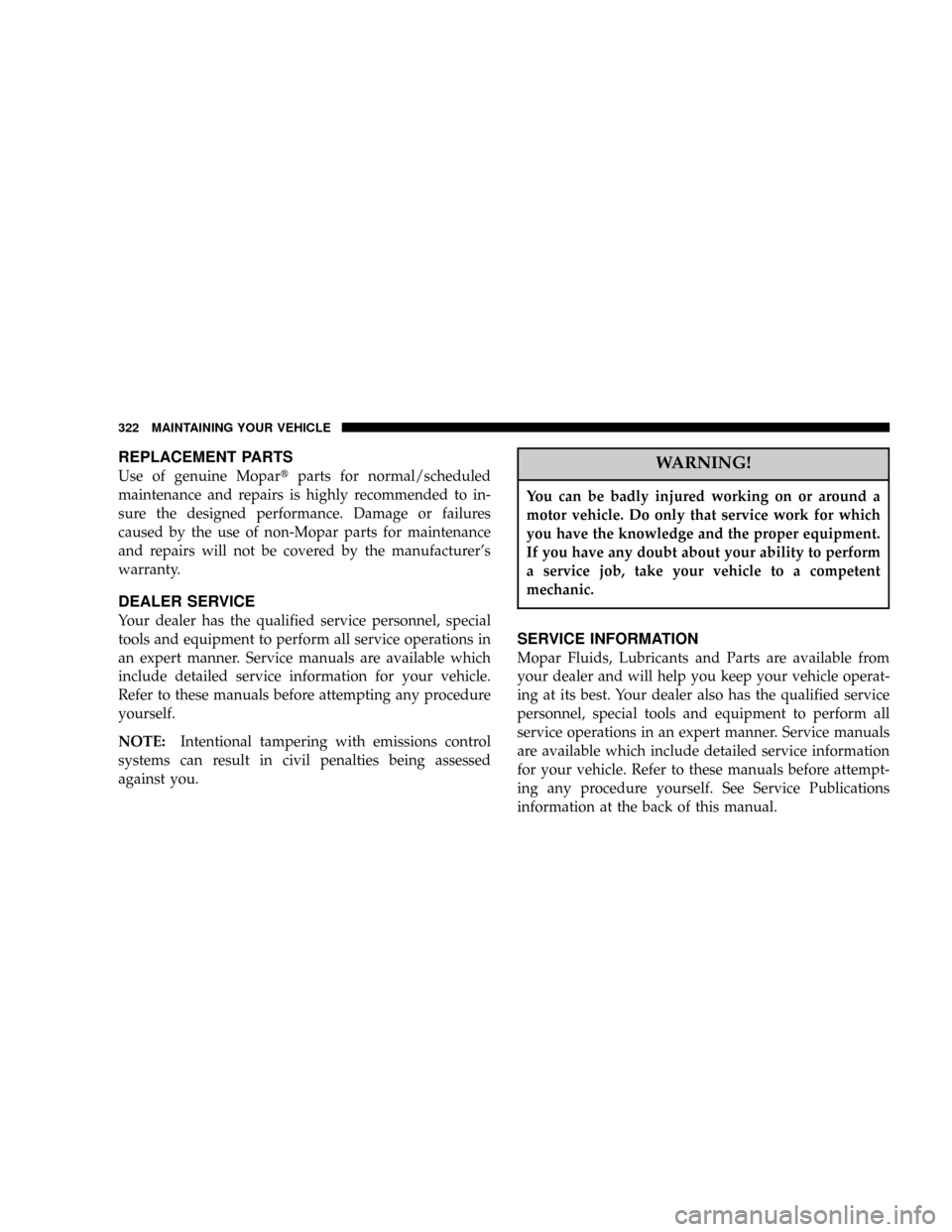
REPLACEMENT PARTS
Use of genuine Mopartparts for normal/scheduled
maintenance and repairs is highly recommended to in-
sure the designed performance. Damage or failures
caused by the use of non-Mopar parts for maintenance
and repairs will not be covered by the manufacturer's
warranty.
DEALER SERVICE
Your dealer has the qualified service personnel, special
tools and equipment to perform all service operations in
an expert manner. Service manuals are available which
include detailed service information for your vehicle.
Refer to these manuals before attempting any procedure
yourself.
NOTE:Intentional tampering with emissions control
systems can result in civil penalties being assessed
against you.
WARNING!
You can be badly injured working on or around a
motor vehicle. Do only that service work for which
you have the knowledge and the proper equipment.
If you have any doubt about your ability to perform
a service job, take your vehicle to a competent
mechanic.
SERVICE INFORMATION
Mopar Fluids, Lubricants and Parts are available from
your dealer and will help you keep your vehicle operat-
ing at its best. Your dealer also has the qualified service
personnel, special tools and equipment to perform all
service operations in an expert manner. Service manuals
are available which include detailed service information
for your vehicle. Refer to these manuals before attempt-
ing any procedure yourself. See Service Publications
information at the back of this manual.
322 MAINTAINING YOUR VEHICLE
Page 323 of 426
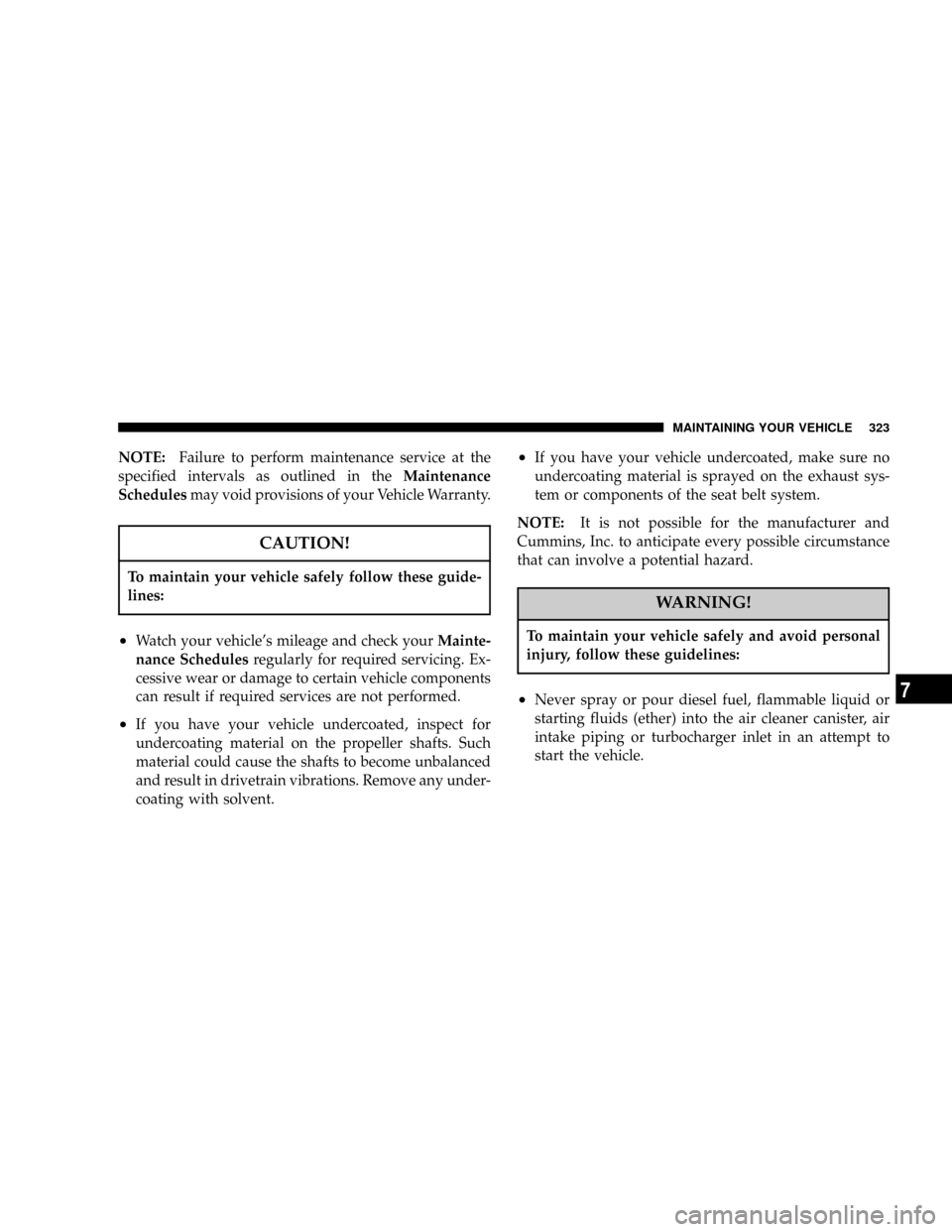
NOTE:Failure to perform maintenance service at the
specified intervals as outlined in theMaintenance
Schedulesmay void provisions of your Vehicle Warranty.
CAUTION!
To maintain your vehicle safely follow these guide-
lines:
²Watch your vehicle's mileage and check yourMainte-
nance Schedulesregularly for required servicing. Ex-
cessive wear or damage to certain vehicle components
can result if required services are not performed.
²If you have your vehicle undercoated, inspect for
undercoating material on the propeller shafts. Such
material could cause the shafts to become unbalanced
and result in drivetrain vibrations. Remove any under-
coating with solvent.
²If you have your vehicle undercoated, make sure no
undercoating material is sprayed on the exhaust sys-
tem or components of the seat belt system.
NOTE:It is not possible for the manufacturer and
Cummins, Inc. to anticipate every possible circumstance
that can involve a potential hazard.
WARNING!
To maintain your vehicle safely and avoid personal
injury, follow these guidelines:
²Never spray or pour diesel fuel, flammable liquid or
starting fluids (ether) into the air cleaner canister, air
intake piping or turbocharger inlet in an attempt to
start the vehicle.
MAINTAINING YOUR VEHICLE 323
7
Page 327 of 426
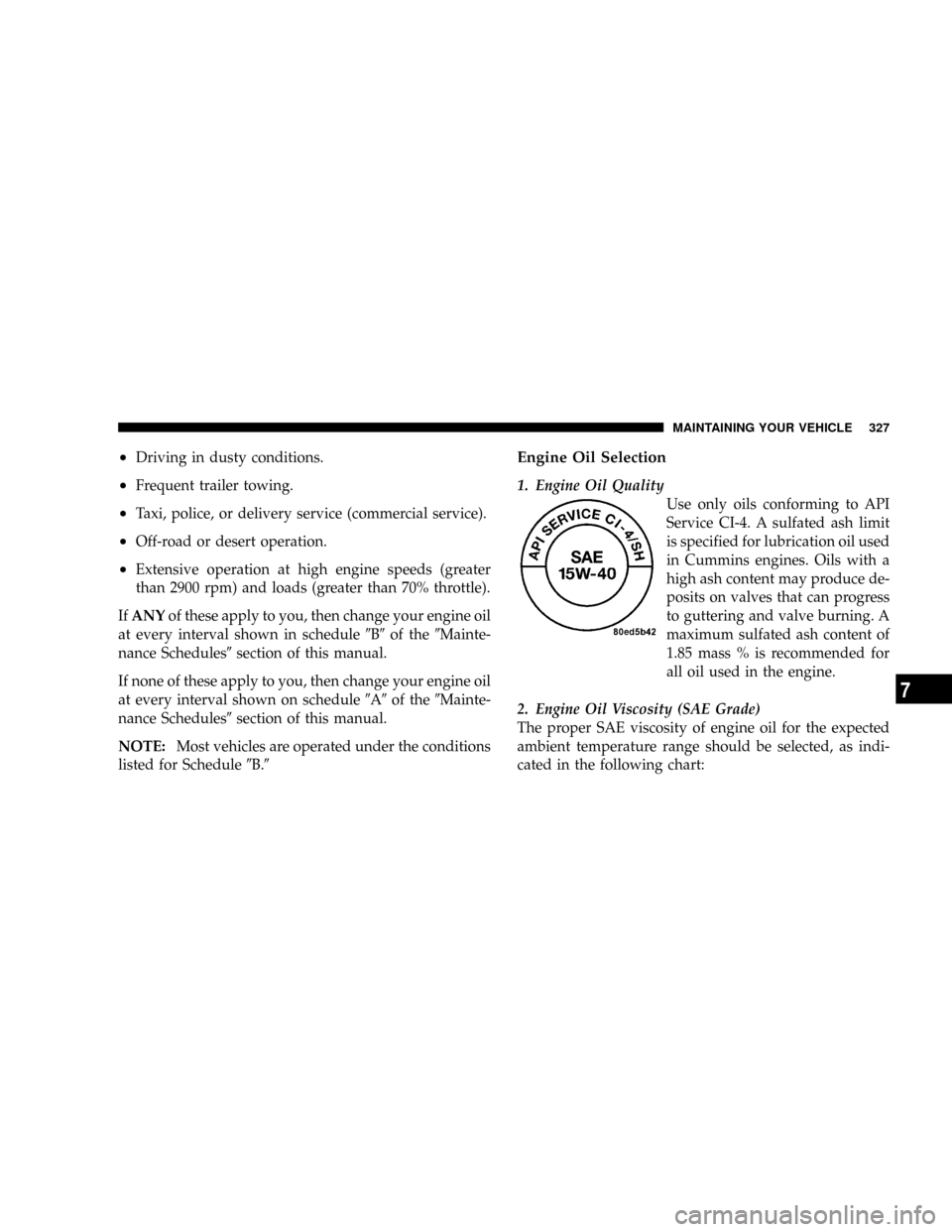
²Driving in dusty conditions.
²Frequent trailer towing.
²Taxi, police, or delivery service (commercial service).
²Off-road or desert operation.
²Extensive operation at high engine speeds (greater
than 2900 rpm) and loads (greater than 70% throttle).
IfANYof these apply to you, then change your engine oil
at every interval shown in schedule9B9of the9Mainte-
nance Schedules9section of this manual.
If none of these apply to you, then change your engine oil
at every interval shown on schedule9A9of the9Mainte-
nance Schedules9section of this manual.
NOTE:Most vehicles are operated under the conditions
listed for Schedule9B.9
Engine Oil Selection
1. Engine Oil Quality
Use only oils conforming to API
Service CI-4. A sulfated ash limit
is specified for lubrication oil used
in Cummins engines. Oils with a
high ash content may produce de-
posits on valves that can progress
to guttering and valve burning. A
maximum sulfated ash content of
1.85 mass % is recommended for
all oil used in the engine.
2. Engine Oil Viscosity (SAE Grade)
The proper SAE viscosity of engine oil for the expected
ambient temperature range should be selected, as indi-
cated in the following chart:
MAINTAINING YOUR VEHICLE 327
7
Page 344 of 426
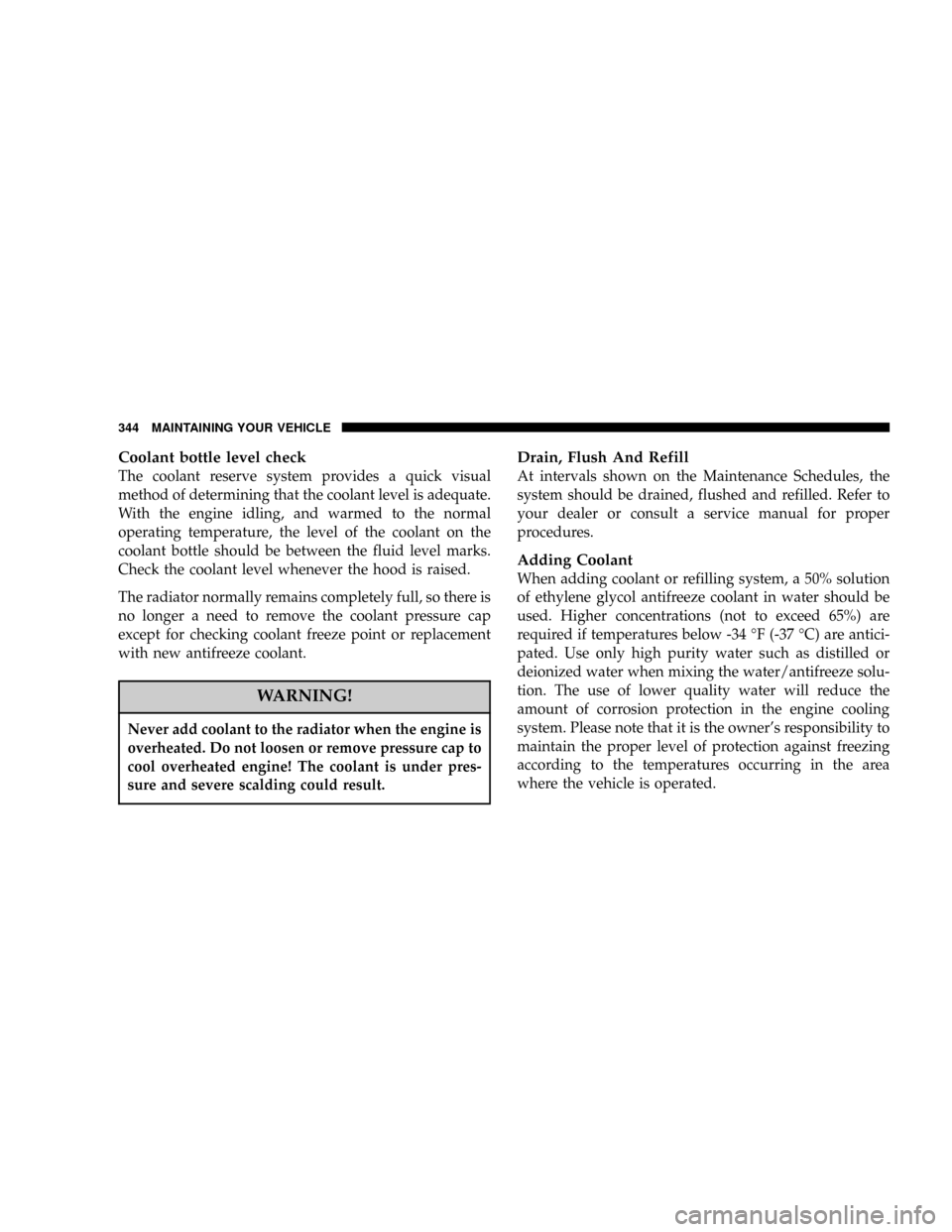
Coolant bottle level check
The coolant reserve system provides a quick visual
method of determining that the coolant level is adequate.
With the engine idling, and warmed to the normal
operating temperature, the level of the coolant on the
coolant bottle should be between the fluid level marks.
Check the coolant level whenever the hood is raised.
The radiator normally remains completely full, so there is
no longer a need to remove the coolant pressure cap
except for checking coolant freeze point or replacement
with new antifreeze coolant.
WARNING!
Never add coolant to the radiator when the engine is
overheated. Do not loosen or remove pressure cap to
cool overheated engine! The coolant is under pres-
sure and severe scalding could result.
Drain, Flush And Refill
At intervals shown on the Maintenance Schedules, the
system should be drained, flushed and refilled. Refer to
your dealer or consult a service manual for proper
procedures.
Adding Coolant
When adding coolant or refilling system, a 50% solution
of ethylene glycol antifreeze coolant in water should be
used. Higher concentrations (not to exceed 65%) are
required if temperatures below -34 ÉF (-37 ÉC) are antici-
pated. Use only high purity water such as distilled or
deionized water when mixing the water/antifreeze solu-
tion. The use of lower quality water will reduce the
amount of corrosion protection in the engine cooling
system. Please note that it is the owner's responsibility to
maintain the proper level of protection against freezing
according to the temperatures occurring in the area
where the vehicle is operated.
344 MAINTAINING YOUR VEHICLE
Page 351 of 426
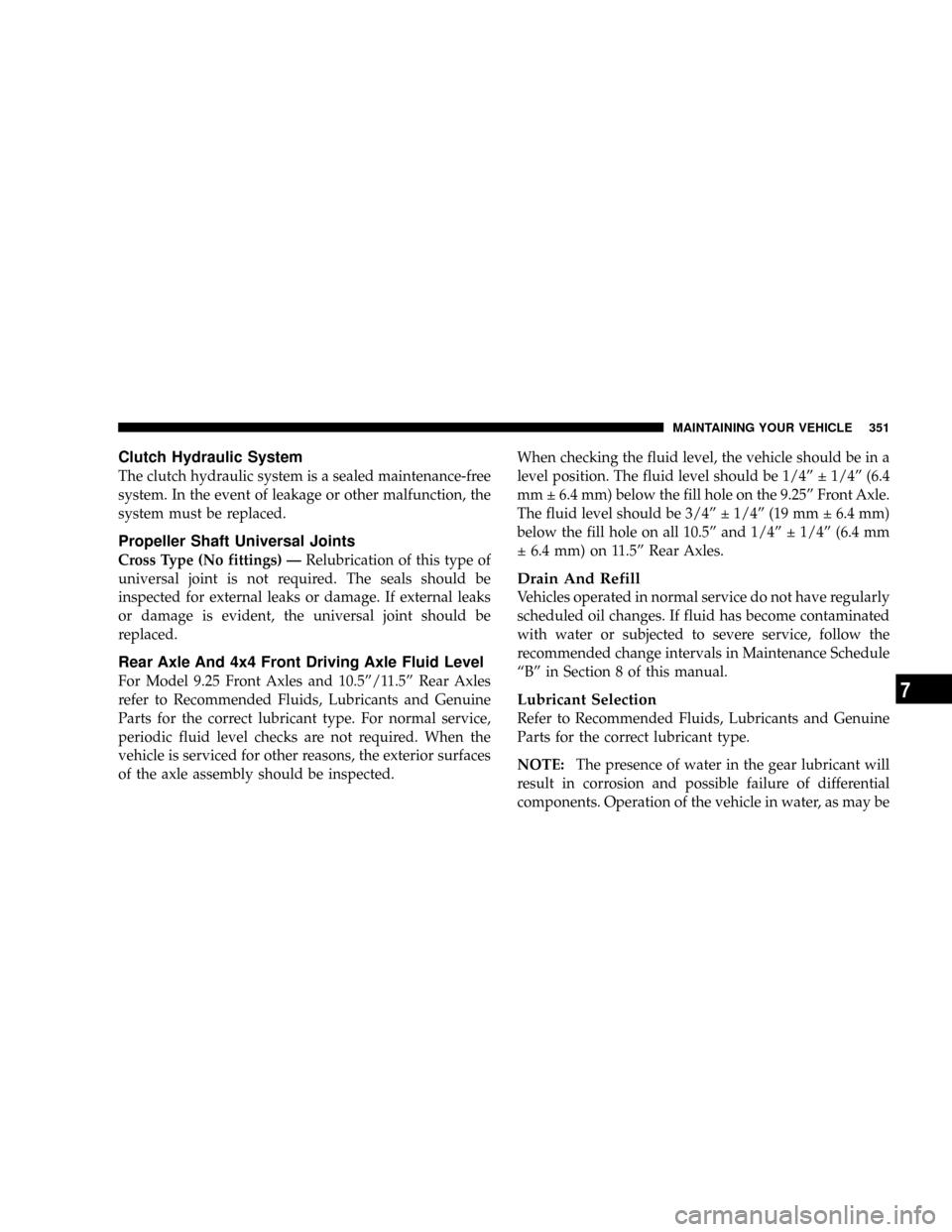
Clutch Hydraulic System
The clutch hydraulic system is a sealed maintenance-free
system. In the event of leakage or other malfunction, the
system must be replaced.
Propeller Shaft Universal Joints
Cross Type (No fittings) ÐRelubrication of this type of
universal joint is not required. The seals should be
inspected for external leaks or damage. If external leaks
or damage is evident, the universal joint should be
replaced.
Rear Axle And 4x4 Front Driving Axle Fluid Level
For Model 9.25 Front Axles and 10.5º/11.5º Rear Axles
refer to Recommended Fluids, Lubricants and Genuine
Parts for the correct lubricant type. For normal service,
periodic fluid level checks are not required. When the
vehicle is serviced for other reasons, the exterior surfaces
of the axle assembly should be inspected.When checking the fluid level, the vehicle should be in a
level position. The fluid level should be 1/4º 1/4º (6.4
mm 6.4 mm) below the fill hole on the 9.25º Front Axle.
The fluid level should be 3/4º 1/4º (19 mm 6.4 mm)
below the fill hole on all 10.5º and 1/4º 1/4º (6.4 mm
6.4 mm) on 11.5º Rear Axles.
Drain And Refill
Vehicles operated in normal service do not have regularly
scheduled oil changes. If fluid has become contaminated
with water or subjected to severe service, follow the
recommended change intervals in Maintenance Schedule
ªBº in Section 8 of this manual.
Lubricant Selection
Refer to Recommended Fluids, Lubricants and Genuine
Parts for the correct lubricant type.
NOTE:The presence of water in the gear lubricant will
result in corrosion and possible failure of differential
components. Operation of the vehicle in water, as may be
MAINTAINING YOUR VEHICLE 351
7
Page 358 of 426
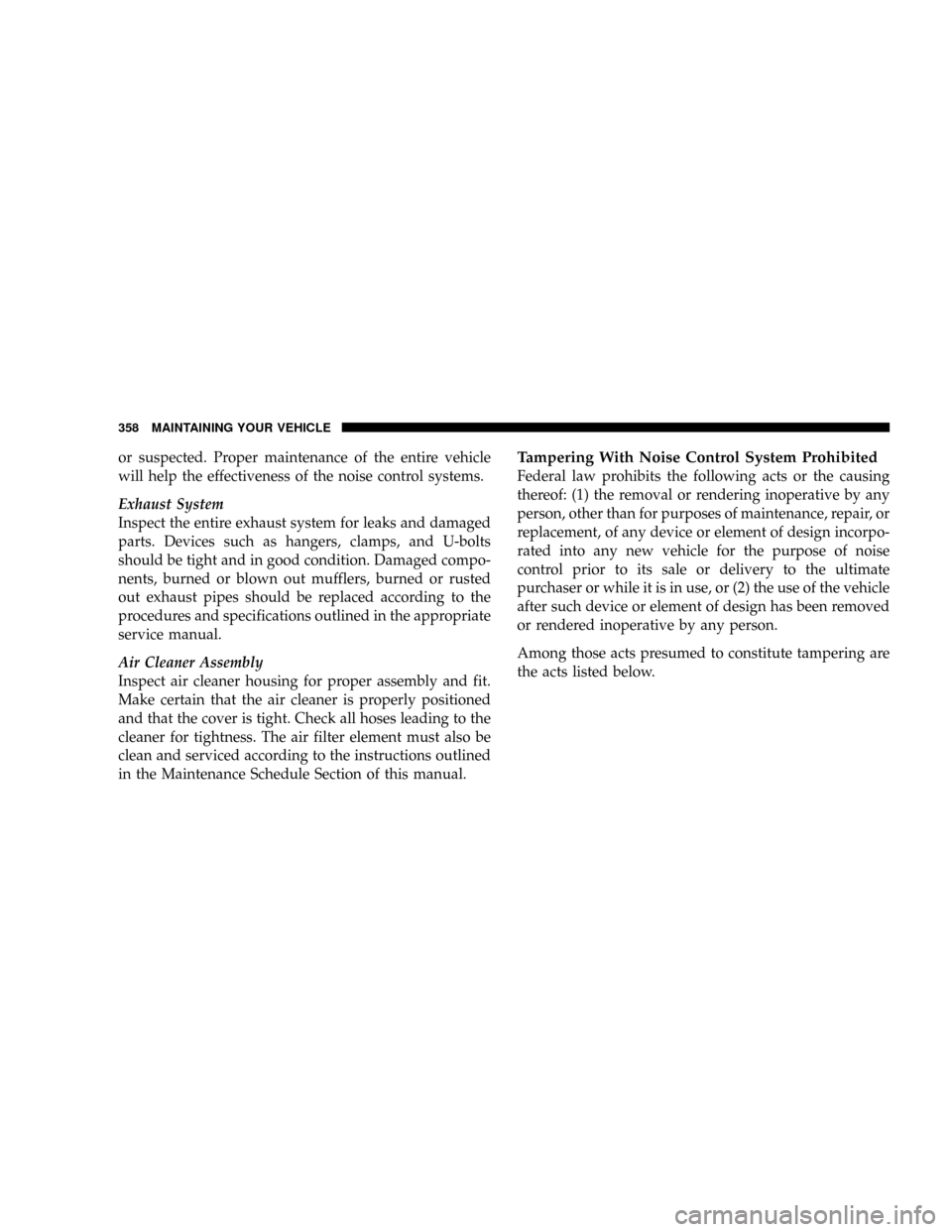
or suspected. Proper maintenance of the entire vehicle
will help the effectiveness of the noise control systems.
Exhaust System
Inspect the entire exhaust system for leaks and damaged
parts. Devices such as hangers, clamps, and U-bolts
should be tight and in good condition. Damaged compo-
nents, burned or blown out mufflers, burned or rusted
out exhaust pipes should be replaced according to the
procedures and specifications outlined in the appropriate
service manual.
Air Cleaner Assembly
Inspect air cleaner housing for proper assembly and fit.
Make certain that the air cleaner is properly positioned
and that the cover is tight. Check all hoses leading to the
cleaner for tightness. The air filter element must also be
clean and serviced according to the instructions outlined
in the Maintenance Schedule Section of this manual.Tampering With Noise Control System Prohibited
Federal law prohibits the following acts or the causing
thereof: (1) the removal or rendering inoperative by any
person, other than for purposes of maintenance, repair, or
replacement, of any device or element of design incorpo-
rated into any new vehicle for the purpose of noise
control prior to its sale or delivery to the ultimate
purchaser or while it is in use, or (2) the use of the vehicle
after such device or element of design has been removed
or rendered inoperative by any person.
Among those acts presumed to constitute tampering are
the acts listed below.
358 MAINTAINING YOUR VEHICLE
Page 384 of 426
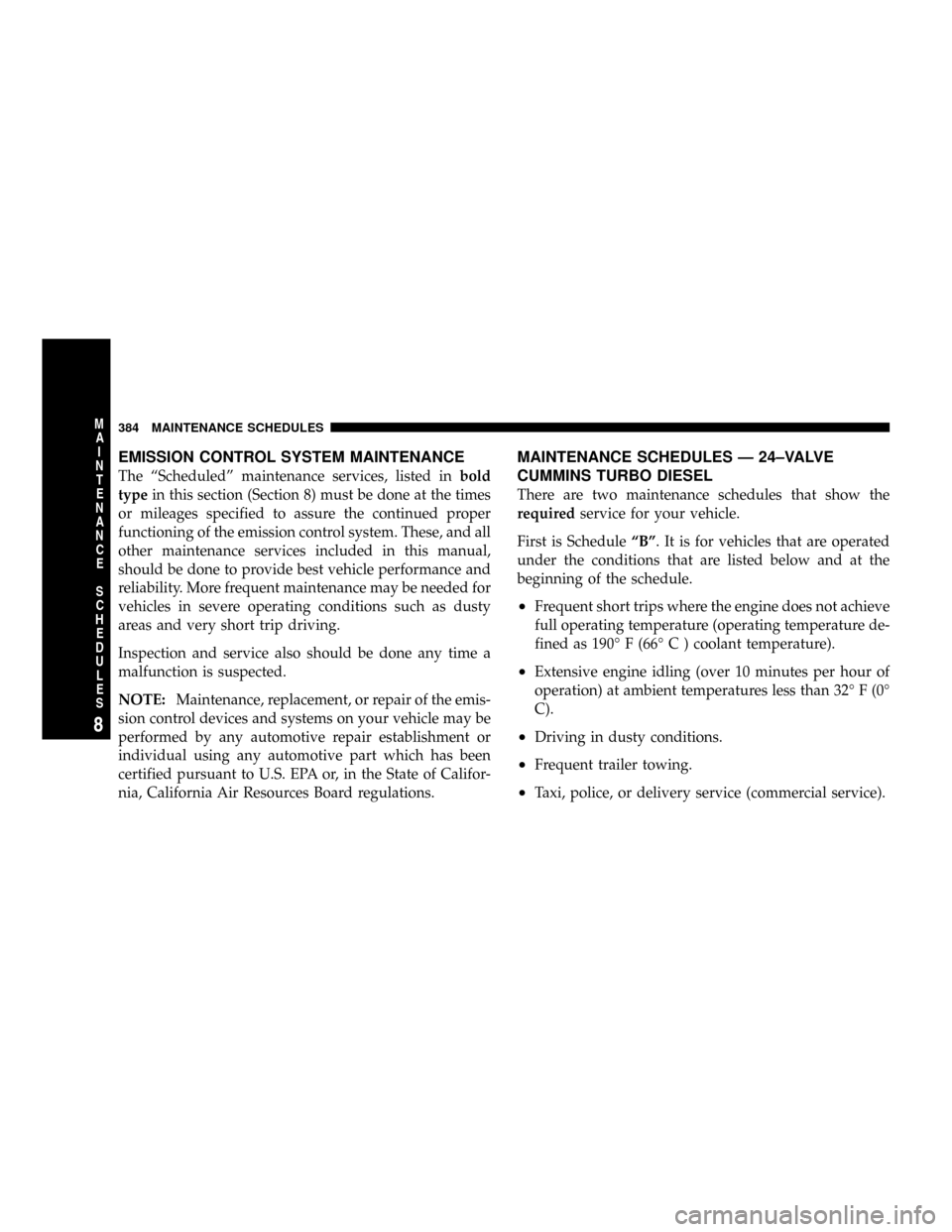
EMISSION CONTROL SYSTEM MAINTENANCE
The ªScheduledº maintenance services, listed inbold
typein this section (Section 8) must be done at the times
or mileages specified to assure the continued proper
functioning of the emission control system. These, and all
other maintenance services included in this manual,
should be done to provide best vehicle performance and
reliability. More frequent maintenance may be needed for
vehicles in severe operating conditions such as dusty
areas and very short trip driving.
Inspection and service also should be done any time a
malfunction is suspected.
NOTE:Maintenance, replacement, or repair of the emis-
sion control devices and systems on your vehicle may be
performed by any automotive repair establishment or
individual using any automotive part which has been
certified pursuant to U.S. EPA or, in the State of Califor-
nia, California Air Resources Board regulations.
MAINTENANCE SCHEDULES Ð 24±VALVE
CUMMINS TURBO DIESEL
There are two maintenance schedules that show the
requiredservice for your vehicle.
First is ScheduleªBº. It is for vehicles that are operated
under the conditions that are listed below and at the
beginning of the schedule.
²Frequent short trips where the engine does not achieve
full operating temperature (operating temperature de-
fined as 190É F (66É C ) coolant temperature).
²Extensive engine idling (over 10 minutes per hour of
operation) at ambient temperatures less than 32É F (0É
C).
²Driving in dusty conditions.
²Frequent trailer towing.
²Taxi, police, or delivery service (commercial service).
384 MAINTENANCE SCHEDULES
8
M
A
I
N
T
E
N
A
N
C
E
S
C
H
E
D
U
L
E
S
Page 387 of 426

Schedule ªBº
Follow schedule ªBº if you usually operate your vehicle
under one or more of the following conditions.
²Frequent short trips where the engine does not achieve
full operating temperature (operating temperature de-
fined as 190É F (66É C ) coolant temperature).
²Extensive engine idling (over 10 minutes per hour of
operation) at ambient temperatures less than 32É F (0É
C).
²Driving in dusty conditions.
²Frequent trailer towing.
²Taxi, police, or delivery service (commercial service).
²Off-road or desert operation.
²Extensive operation at high engine speeds (greater
than 2900 rpm) and loads (greater than 70% throttle).
SCHEDULE ªBº 387
8
M
A
I
N
T
E
N
A
N
C
E
S
C
H
E
D
U
L
E
S